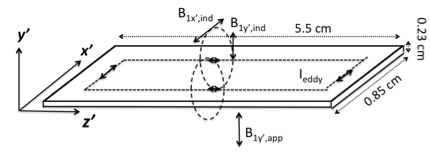Mapping B1-induced Eddy Current Effects Near Metallic Structures in MR Images: A Comparison of Simulation and Experiment
- 1. University of New Brunswick, Physics, Fredericton, Canada
- 2. University of Birmingham, School of Chemistry, Birmingham, United Kingdom
Magnetic resonance imaging (MRI) in the presence of metallic structures is very common in medical and non-medical fields. The presence of metallic structures in the sample space causes image distortions. Recently, the challenges of imaging near metal surfaces in electrochemical MRI studies have been investigated [1], [2], [3], [4]. Metallic structures cause MRI image distortions by three mechanisms: (1) static field distortion through magnetic susceptibility mismatch, (2) eddy currents induced by switched magnetic field gradients and (3) radio frequency (RF) induced eddy currents [5]. Single point ramped imaging with T1 enhancement (SPRITE) [6] MRI measurements can be employed to isolate the effects of metal objects on the RF field.This is challenging with conventional MRI methods, which cannot readily separate the three effects.
RF induced artifacts were investigated experimentally by analyzing image distortions surrounding two geometrically identical metallic strips of Al and Pb. B1 mapping with SPRITE [7] was employed to measure the B1 field around the strips of metal. The strip geometry was chosen to mimic metal electrodes employed in electrochemistry studies. Simulations are employed to investigate the RF field induced eddy currents in the two metallic strips.
Figs. 1(a) and 1(b) show 2D slices of the relative B1 field distribution (B1/B1max) (central xy plane) from experimental 3D B1 maps for a uniform vial of gel enclosing a strip of Al and Pb, respectively, with orientation and dimensions as shown in Fig. 2. B1 artifacts will be maximized when the B1 field is perpendicular to the surface of the strip. The dipole pattern in the xy plane is in agreement with theory, experiments and the simulation results in Fig. 1(c), confirming the excellent performance of our B1 mapping method to measure B1 in the presence of metallic structures.The difference in electrical conductivity between the metals has a minimal effect.
The results are particularly important for NMR and MRI of batteries and other electrochemical devices.


- [1] M.M. Britton, P.M. Bayley, P.C. Howlett, A.J. Davenport, M. Forsyth, (2013), In situ, real-time visualization of electrochemistry using magnetic resonance imaging, J. Phys. Chem. Lett., 4, 3019-3023
- [2] Z. Zhang, J. Martin, J. Wu, H. Wang, K. Promislow, B.J. Balcom, (2008), Magnetic resonance imaging of water content across the Nafion membrane in an operational PEM fuel cel, J. Magn. Reson., 193, 259-266
- [3] R. Bhattacharyya, B. Key, H. Chen, A.S. Best, A.F. Hollenkamp, C.P. Grey, (2010), In situ NMR observation of the formation of metallic lithium microstructures in lithium batteries, Nature Materials, 9, 504-510
- [4] A.J. Ilott, S. Chandrashekar, A. Klöckner, H. Jung Chang , N.M. Trease, C.P. Grey, L. Greengard, A. Jerschow, (2014), Visualizing skin effects in conductors with MRI: Li MRI experiments and calculations, J. Magn. Reson., 245, 143-149
- [5] C.R. Camacho, D.B. Plewes, R.M. Henkelman, (1995), Nonsusceptibility artifacts due to metallic objects in MR imaging, J. Magn. Reson., 5, 75-88
- [6] B.J. Balcom, R.P. MacGregor, S.D. Beya, D.P. Green, R.L. Armstrong, T.W. Bremner, (1996), Single-point ramped imaging with T1 enhancement (SPRITE), J. Magn. Reson.,123, 131-134
- [7] S. Vashaee, B. Newling, B. MacMillan, B.J. Balcom, (2013), B1 mapping with a pure phase encode approach, J. Magn. Reson., 232, 68-75
- [8] S. Vashaee, F. Goora, M.M. Britton B. Newling, B.J. Balcom, (2015), Mapping B1-induced eddy current effects near metallic structures in MR images: a comparison of simulation and experiment, J. Magn. Reson., 250, 17-24
